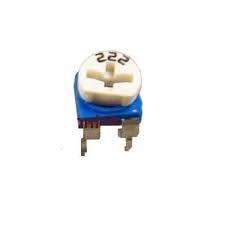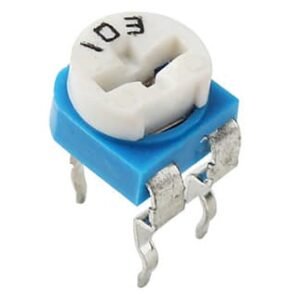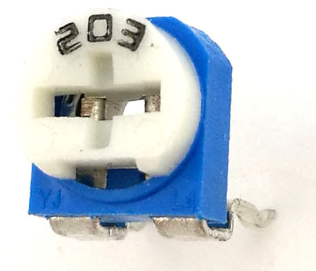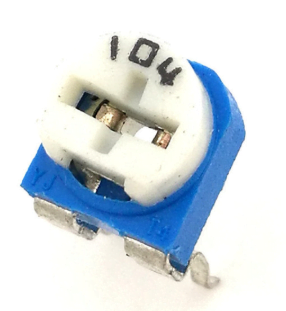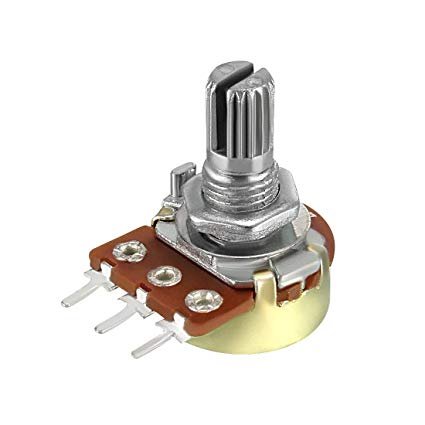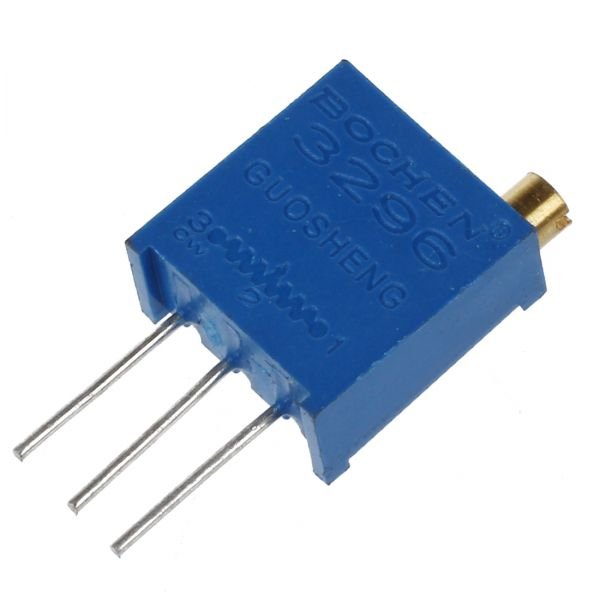-
1K Potentiometer (Pot) is a manually adjustable variable resistor with 3 terminals. Two terminals are connected to both ends of a resistive element, and the third terminal connects to a sliding contact, called a wiper, moving over the resistive element.The position of the wiper determines the output voltage of the potentiometer. small screw driver can be used for calibration of resistance value.
-
- Resistance: 2K Ohm,
- Resistor Tolerance: ±10% Max
- Max Voltage: 50V
- Rating Power: 0.1W
- Technology: Carbon Film
- Adjustment Type: Top Adjustment
-
A potentiometer is a manually adjustable variable resistor with 3 terminals. Two terminals are connected to both ends of a resistive element, and the third terminal connects to a sliding contact, called a wiper, moving over the resistive element.The position of the wiper determines the output voltage of the potentiometer. small screw driver can be used for calibration of resistance value.
-
A potentiometer is a manually adjustable variable resistor with 3 terminals. Two terminals are connected to both ends of a resistive element, and the third terminal connects to a sliding contact, called a wiper, moving over the resistive element.The position of the wiper determines the output voltage of the potentiometer. small screw driver can be used for calibration of resistance value.
-
- Resistance: 203 20K Ohm,
- Resistor Tolerance: ±10% Max
- Max Voltage: 50V
- Rating Power: 0.1W
- Technology: Carbon Film
- Adjustment Type: Top Adjustment
-
- Resistance: 503 50K Ohm,
- Resistor Tolerance: ±10% Max
- Max Voltage: 50V
- Rating Power: 0.1W
- Technology: Carbon Film
- Adjustment Type: Top Adjustment
-
- Resistance: 100K Ohm,
- Resistor Tolerance: ±10% Max
- Max Voltage: 50V
- Rating Power: 0.1W
- Technology: Carbon Film
- Adjustment Type: Top Adjustment
-
A potentiometer knob is an accessory that is used as a control knob for a potentiometer.
-
A potentiometer is a manually adjustable variable resistor with 3 terminals. Two terminals are connected to both ends of a resistive element, and the third terminal connects to a sliding contact, called a wiper, moving over the resistive element. The position of the wiper determines the output voltage of the potentiometer. The potentiometer essentially functions as a variable voltage divider. The resistive element can be seen as two resistors in series(potentiometer resistance), where the wiper position determines the resistance ratio of the first resistor to the second resistor. A potentiometer is also commonly known as a potentiometer or pot. The most common form of potmeter is the single turn rotary potmeter. This type of pot is often used in audio volume control (logarithmic taper) as well as many other applications. Different materials are used to construct potentiometers, including carbon composition, cermet, wirewound, conductive plastic or metal film.
-
A potentiometer is a manually adjustable variable resistor with 3 terminals. Two terminals are connected to both ends of a resistive element, and the third terminal connects to a sliding contact, called a wiper, moving over the resistive element. The position of the wiper determines the output voltage of the potentiometer. The potentiometer essentially functions as a variable voltage divider. The resistive element can be seen as two resistors in series(potentiometer resistance), where the wiper position determines the resistance ratio of the first resistor to the second resistor. A potentiometer is also commonly known as a potentiometer or pot. The most common form of potmeter is the single turn rotary potmeter. This type of pot is often used in audio volume control (logarithmic taper) as well as many other applications. Different materials are used to construct potentiometers, including carbon composition, cermet, wirewound, conductive plastic or metal film.
-
A potentiometer is a manually adjustable variable resistor with 3 terminals. Two terminals are connected to both ends of a resistive element, and the third terminal connects to a sliding contact, called a wiper, moving over the resistive element. The position of the wiper determines the output voltage of the potentiometer. The potentiometer essentially functions as a variable voltage divider. The resistive element can be seen as two resistors in series(potentiometer resistance), where the wiper position determines the resistance ratio of the first resistor to the second resistor. A potentiometer is also commonly known as a potentiometer or pot. The most common form of potmeter is the single turn rotary potmeter. This type of pot is often used in audio volume control (logarithmic taper) as well as many other applications. Different materials are used to construct potentiometers, including carbon composition, cermet, wirewound, conductive plastic or metal film.
-
A potentiometer is a manually adjustable variable resistor with 3 terminals. Two terminals are connected to both ends of a resistive element, and the third terminal connects to a sliding contact, called a wiper, moving over the resistive element. The position of the wiper determines the output voltage of the potentiometer. The potentiometer essentially functions as a variable voltage divider. The resistive element can be seen as two resistors in series(potentiometer resistance), where the wiper position determines the resistance ratio of the first resistor to the second resistor. A potentiometer is also commonly known as a potentiometer or pot. The most common form of potmeter is the single turn rotary potmeter. This type of pot is often used in audio volume control (logarithmic taper) as well as many other applications. Different materials are used to construct potentiometers, including carbon composition, cermet, wirewound, conductive plastic or metal film.
-
A potentiometer is a manually adjustable variable resistor with 3 terminals. Two terminals are connected to both ends of a resistive element, and the third terminal connects to a sliding contact, called a wiper, moving over the resistive element. The position of the wiper determines the output voltage of the potentiometer. The potentiometer essentially functions as a variable voltage divider. The resistive element can be seen as two resistors in series(potentiometer resistance), where the wiper position determines the resistance ratio of the first resistor to the second resistor. A potentiometer is also commonly known as a potentiometer or pot. The most common form of potmeter is the single turn rotary potmeter. This type of pot is often used in audio volume control (logarithmic taper) as well as many other applications. Different materials are used to construct potentiometers, including carbon composition, cermet, wirewound, conductive plastic or metal film.
-
A potentiometer is a manually adjustable variable resistor with 3 terminals. Two terminals are connected to both ends of a resistive element, and the third terminal connects to a sliding contact, called a wiper, moving over the resistive element. The position of the wiper determines the output voltage of the potentiometer. The potentiometer essentially functions as a variable voltage divider. The resistive element can be seen as two resistors in series(potentiometer resistance), where the wiper position determines the resistance ratio of the first resistor to the second resistor. A potentiometer is also commonly known as a potentiometer or pot. The most common form of potmeter is the single turn rotary potmeter. This type of pot is often used in audio volume control (logarithmic taper) as well as many other applications. Different materials are used to construct potentiometers, including carbon composition, cermet, wirewound, conductive plastic or metal film.
-
500K Ohm Rotary Potentiometer / Variable Resistor
Original price was: ₨50.00.₨39.00Current price is: ₨39.00. Quick View500K Ohm Rotary Potentiometer / Variable Resistor is a manually adjustable variable resistor with 3 terminals. Two terminals are connected to both ends of a resistive element, and the third terminal connects to a sliding contact, called a wiper, moving over the resistive element. The position of the wiper determines the output voltage of the potentiometer. The potentiometer essentially functions as a variable voltage divider. The resistive element can be seen as two resistors in series(potentiometer resistance), where the wiper position determines the resistance ratio of the first resistor to the second resistor. A potentiometer is also commonly known as a potentiometer or pot. The most common form of potmeter is the single turn rotary potmeter. This type of pot is often used in audio volume control (logarithmic taper) as well as many other applications. Different materials are used to construct potentiometers, including carbon composition, cermet, wirewound, conductive plastic or metal film.
-
1M Ohm Rotary Potentiometer / Variable Resistor
Original price was: ₨50.00.₨39.00Current price is: ₨39.00. Quick View1M Ohm Rotary Potentiometer / Variable Resistor is a manually adjustable variable resistor with 3 terminals. Two terminals are connected to both ends of a resistive element, and the third terminal connects to a sliding contact, called a wiper, moving over the resistive element. The position of the wiper determines the output voltage of the potentiometer. The potentiometer essentially functions as a variable voltage divider. The resistive element can be seen as two resistors in series(potentiometer resistance), where the wiper position determines the resistance ratio of the first resistor to the second resistor. A potentiometer is also commonly known as a potentiometer or pot. The most common form of potmeter is the single turn rotary potmeter. This type of pot is often used in audio volume control (logarithmic taper) as well as many other applications. Different materials are used to construct potentiometers, including carbon composition, cermet, wirewound, conductive plastic or metal film.
-
Variable resistor 50K Potentiometer / Variable Resistor
Original price was: ₨50.00.₨39.00Current price is: ₨39.00. Quick ViewVariable resistor 50K Potentiometer / Variable Resistor (50K Ohm) is a manually adjustable variable resistor with 3 terminals. Two terminals are connected to both ends of a resistive element, and the third terminal connects to a sliding contact, called a wiper, moving over the resistive element. The position of the wiper determines the output voltage of the potentiometer. The potentiometer essentially functions as a variable voltage divider. The resistive element can be seen as two resistors in series(potentiometer resistance), where the wiper position determines the resistance ratio of the first resistor to the second resistor. A potentiometer is also commonly known as a potentiometer or pot. The most common form of potmeter is the single turn rotary potmeter. This type of pot is often used in audio volume control (logarithmic taper) as well as many other applications. Different materials are used to construct potentiometers, including carbon composition, cermet, wirewound, conductive plastic or metal film.
-
A potentiometer is a manually adjustable variable resistor with 3 terminals. Two terminals are connected to both ends of a resistive element, and the third terminal connects to a sliding contact, called a wiper, moving over the resistive element. The position of the wiper determines the output voltage of the potentiometer.
-
- Multi-turn / Cermet / Industrial / Sealed
- 5 terminal styles
- Tape and reel packaging available
- Chevron seal design
- Mounting hardware available (H-117P)
- RoHS compliant
-
- Multi-turn / Cermet / Industrial / Sealed
- 5 terminal styles
- Tape and reel packaging available
- Chevron seal design
- Mounting hardware available (H-117P)
- RoHS compliant
-
10K ohm Trimmer Trim Pot Variable Resistor 3296W 3296 Variable Resistor is a manually adjustable variable resistor with 3 terminals. Two terminals are connected to both ends of a resistive element, and the third terminal connects to a sliding contact, called a wiper, moving over the resistive element. The position of the wiper determines the output voltage of the potentiometer. The potentiometer essentially functions as a variable voltage divider. The resistive element can be seen as two resistors in series(potentiometer resistance), where the wiper position determines the resistance ratio of the first resistor to the second resistor. A potentiometer is also commonly known as a potentiometer or pot. The most common form of potmeter is the single turn rotary potmeter. This type of pot is often used in audio volume control (logarithmic taper) as well as many other applications. Different materials are used to construct potentiometers, including carbon composition, cermet, wirewound, conductive plastic or metal film.
-
Multiturn Variable Potentiometer 5K
Original price was: ₨495.00.₨396.00Current price is: ₨396.00. Quick ViewA potentiometer is a manually adjustable variable resistor with 3 terminals. Two terminals are connected to both ends of a resistive element, and the third terminal connects to a sliding contact, called a wiper, moving over the resistive element. The position of the wiper determines the output voltage of the potentiometer.
-
Multiturn Variable Potentiometer 10K / Variable Resistor. There are lots of trimpots out there. Some are very large, some so small they require a screwdriver. Here at ELECTRONATION, we just needed a simple one that worked. This 10K trimmable potentiometer has a small knob built right in and it’s breadboard friendly to boot! Perfect for your next LCD contrast adjuster, opamp setting, or volume level. This is 3296W model 103 within the datasheet.
-
Multiturn Variable Potentiometer 1K
Original price was: ₨600.00.₨550.00Current price is: ₨550.00. Quick ViewA potentiometer is a manually adjustable variable resistor with 3 terminals. Two terminals are connected to both ends of a resistive element, and the third terminal connects to a sliding contact, called a wiper, moving over the resistive element. The position of the wiper determines the output voltage of the potentiometer.






